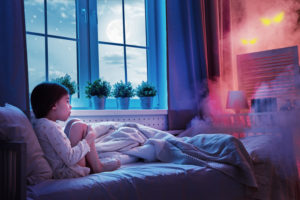 The dreaded nightmare. Your child wakes up in a sweat for the third night in a row, screaming, convinced there are monsters lurking, wanting to cause harm. You are left feeling helpless and concerned. The most you can do is to soothe your child and say it was just a dream.
The dreaded nightmare. Your child wakes up in a sweat for the third night in a row, screaming, convinced there are monsters lurking, wanting to cause harm. You are left feeling helpless and concerned. The most you can do is to soothe your child and say it was just a dream.
You might wonder to yourself why the nightmares keep occurring, and more importantly, what you might be able to do about it. If your child experiences nightmares regularly, this article may be helpful.
What Causes Nightmares?
Dreams, good or bad, are not only a vital part of a child’s emotional and cognitive development, but they can also can serve as a map to your child’s inner world.
According to Bay Area child psychologist Alan Siegel, nightmares can be a clear beacon for a parent, guardian, teacher, or counselor, in terms of the psyche, especially when children are faced with stressful changes in their routine or are going through a particularly challenging time. Through childhood development research and personal case studies, Siegel found that anything from the first day of school to changing residence can lead to nightmares. More severe cases may stem from events such as divorce, accidents, or a death in the family.
Humans go through specific stages of development, with the most dramatic occurring during childhood and adolescence. During these stages, there is much emotional, biological and mental intensity, and a great need for balance or comfort. For example, children going to school for the first time will most likely experience stress as their environment is quickly and dramatically changed. Dreams, often in the form of nightmares, may then be more likely to occur during these transitions as the child copes with the new challenges that inevitably must arise in the stages of life.
Dreaming is also a part of our need for homeostasis or balance in our lives, especially during periods of transition and stress. In the book Encountering the Monster: Pathways in Children’s Dreams, psychologist Denyse Beaudet collected over 100 dreams in an 11-week period from 15 preschoolers between the ages of 5 and 6.
At first the task seemed daunting in that the dreams of children are multifaceted and greatly diverse in content. Further, the dreams of children may subject to modification: for most children, the line between reality and fantasy is very fine, and their gift of imagination can easily alter dream recall.
However, by looking at a series of dreams instead of a single dream, Beaudet was able to mark the evolution in a child’s life in terms of how that child found balance to stressful situations. For example, monster themes, which were quite frequent, could be quite telling in terms of how a child deals with adversaries in dreams and in life. Is the child combative or complacent? Does the child have help or do they feel helpless and alone?
Dreaming is also a part of our need for homeostasis or balance in our lives, especially during periods of transition and stress.
In one particular case, a girl recorded a series of 11 such monster dreams where the focal point included the vehicle in which she moved through the dream. In the first dream, she is being pushed inside a baby carriage while encountering the monster. In later dreams, she rides in a car and then eventually rides a bicycle of her own volition. Although she did not yet know how to ride a bicycle in waking life, it became clear to Beaudet, through working with her dreams, that the child was gaining more control and emotional balance in her life. “From one dream to the next, the various vehicles recur…express(ing) in many ways the experience of movement and displacement in (her) psychic life.”
Beaudet’s research, mindful of dreams as psychic odysseys, proved to be quite powerful in finding correlations between dreams and childhood development by letting the dreams speak for themselves. In order to do this as Beaudet suggests, we must hold the dreams with curiosity and creativity and without judgment or fear.
Dealing with Recurring Nightmares
But what happens when nightmares occur and cannot be traced clearly to a particular event, or the parent has no idea of the significance of the event causing the nightmare?
Here are some tips that may be helpful for guiding children and their dreams:
- Do not dismiss the dream. The first and most important tool is the ability to listen without judgment. In Kate Adams’ book Unseen Worlds, she shares the importance of her research and work as a receiver of children’s dreams. Many of the children from her cases “retreated into a world of silence until a researcher with a genuine interest came along.” When we give children our attention and care by providing a safe space in which they can talk freely, this helps build trust, connection, and confidence. This is essential, because we want our children to know it is safe to come to us for help and guidance.
- Provide dream journals for children. An artist’s sketchbook with blank pages is a good choice because it evokes freedom to use the imagination. Encourage children to sketch, color, paint, collage, or illustrate their dreams. Older children may also be able to use words to describe their dreams, through poetry, prose, or myth.
- Invite children to share their dreams. A wonderful way to encourage dream sharing is to create a dream-friendly environment. Why not incorporate family dream sharing as part of your morning process? It may be easier for reluctant children to talk about their dreams if family members are discussing their own dreams, too.
- Ask open-ended questions to invite your child’s creativity. If we are open and curious, instead of putting our own beliefs and opinions on what we think our child’s dreams might mean, we show them we are receptive to their thoughts. Allow children to offer their own interpretations without asking leading questions or offering an explanation. Our children often surprise us with their wisdom and resilience.
- Offer reassurance for difficult or troubling dreams. I believe it is essential that we hold space for our children’s dreams and validate their fears. If they are distressed, our comfort and support can help them feel more at ease. Reassurance may be especially important if the disturbing dream involves great injury or death to a loved one.
John Milton writes in Paradise Regained, “The childhood shows the man as morning shows the day.” Can we not also say this about dreams? If we can unflinchingly look into our child’s dreams, are we not bearing witness to the evolution of their soul?
I say that we, as parents, counselors and teachers, cannot afford not to take this journey and use the dream maps of the psyche to guide our way. If you are unsure of how best to support a child in your life, you can find help and support from a qualified and compassionate counselor.
References:
- Adams, K. (2010). Unseen worlds: Looking through the lens of childhood. London, UK: Jessica Kingsley Publishers.
- Beaudet, D. (1990). Encountering the monster: Pathways in children’s dreams. New York, NY: Continuum.
- Bulkeley, K., & Bulkeley, P. M. (2012). Children’s dreams; Understanding the most memorable dreams and nightmares of childhood. Lanham, MD: Rowman & Littlefield Publishers.
- Bulkeley, K., & Siegel, A. (1998). Dreamcatching: Every parent’s guide to exploring and understanding children’s dreams and nightmares. New York, NY: Three Rivers Press.
- Johnson, C. R., & Campbell, J., Eds. (2016). (Sleep monsters and superheroes: Empowering children through creative dreamplay. Santa Barbara, CA: Praeger.
- Mallon, B. (2002). Dream time with children: Learning to dream, dreaming to learn. London, UK: Jessica Kingsley Publishers.
© Copyright 2018 GoodTherapy.org. All rights reserved. Permission to publish granted by Linda H. Mastrangelo, MA, LMFT, GoodTherapy.org Topic Expert
The preceding article was solely written by the author named above. Any views and opinions expressed are not necessarily shared by GoodTherapy.org. Questions or concerns about the preceding article can be directed to the author or posted as a comment below.

 When Trauma Follows You into Your Nightmares
When Trauma Follows You into Your Nightmares Kids May Be More Stressed Than Parents Think
Kids May Be More Stressed Than Parents Think Dreaming Is Believing: A Method for Analyzing Dreams
Dreaming Is Believing: A Method for Analyzing Dreams